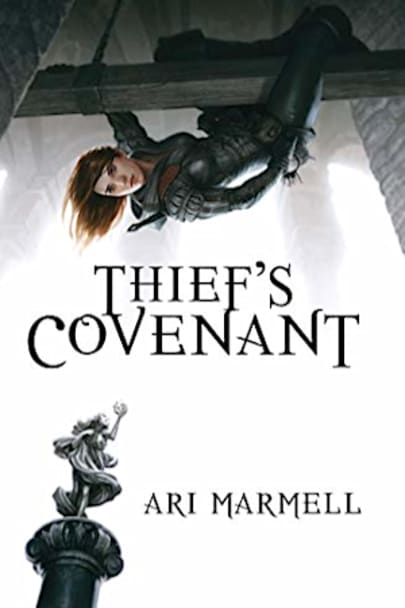Once she was Adrienne Satti. An orphan of Davillon, she had somehow escaped destitution and climbed to the ranks of the city’s aristocracy in a rags-to-riches story straight from an ancient fairy tale. Until one horrid night, when a conspiracy of forces–human and other–stole it all away in a flurry of blood and murder. Today she is Widdershins, a thief making her way through Davillon’s … underbelly with a sharp blade, a sharper wit, and the mystical aid of Olgun, a foreign god with no other worshippers but Widdershins herself. It’s not a great life, certainly nothing compared to the one she once had, but it’s hers.
But now, in the midst of Davillon’s political turmoil, an array of hands are once again rising up against her, prepared to tear down all that she’s built. The City Guard wants her in prison. Members of her own Guild want her dead. And something horrid, something dark, something ancient is reaching out for her, a past that refuses to let her go.
Widdershins and Olgun are going to find answers, and justice, for what happened to her–but only if those who almost destroyed her in those years gone by don’t finish the job first.
more



I first encountered this title when researching books that read like video games, and after reading it, am surprised that it took me the effort of research to actually find out about it. It’s a title that has appeal for a wide variety of audiences. Fans of historical adventure, low fantasy, kick-butt heroines, good old-fashioned sneakery, and playing stealth games solely to climb on things will all find something to like in this novel.
The most perfect audience for Thief’s Covenant is the teen who just wants to play Assassin’s Creed but has a book report due tomorrow that hasn’t even been started yet. It’s quick, it’s witty, and its combination of stealth tactics, action, and political intrigue basically render it Assassin’s Creed with a girl.
Widdershins herself deserves to rank among fan-favorite heroines like Graceling’s Katsa and pretty much every Tamora Pierce heroine. She’s quick-witted, adaptable, determined, and in no way is she going to let the powers that be step all over her. When both the Davillon City Guard and Finders’ Guild (that is—ha—thieves’ guild) start harassing her for (mostly) unfounded reasons, she decides to show them both by stealing an item from a visiting dignitary—not because she actually wants the item, just to show that she won’t be so easily contained. Her very nickname suggests opposition, “widdershins” meaning “counterclockwise.” Of course, as exemplified by the aforementioned adventure, her determination sometimes (read: often) translates into headstrong recklessness. Widdershins frequently gets into trouble without the aid of any force but herself. For readers, this isn’t a bad thing. It’s fun to watch her fall into exponentially worsening trouble because it means she’ll have to do something equivalently clever to get out of it, which she frequently does.
She’s also too busy running from the City Guard, Finders’ Guild thugs, other people who generally want her dead, and oh, demons, to have time for a romance, which is a refreshing change from other heroines whose goals are complicated by the two hot guys vying for their attentions.
Her relationship with the god in her head, Olgun, is fascinating, too, as is the entire concept of religion in this setting. Davillon’s is a faith centered around a Pact of 147 acknowledged gods, from which families and organizations choose to take as household deities and official patrons. The gods are active in the city, visible through tangible boons granted to worshippers; Widdershins’ in particular helps her thievery in subtle ways. These gods also regulate the behavior of the city; organizations with patron gods of the Pact can’t openly attack one another without violating the Pact, which is why the City Guard can’t take on the Finder’s Guild without resorting to sneaky methods (or otherwise starting a war). The resulting tension, combined with a plot involving the history of Widdershins’ personal god, makes this religion one of the most interesting pieces of world-building in the book.
The writing itself is another strength of the novel. The prose is peppered with amusing, ironic wit, and the style balances the derring-do and drama quite well, never becoming too over-the-top or too melodramatic. Also, despite being the first book in a series, the story functions as a standalone, and thus is a welcome departure from the cliffhanger endings favored by other YA series starters.
For squeamish readers, it’s worth noting that the novel opens in the midst of carnage involving a ton of murdered bodies that have been hacked into such fine pieces that the characters can’t figure out which body parts belong to which victim. However, that is by far the worst of the violence in the book, and most that occurs is pretty standard for a book of this type.
Overall, Thief’s Covenant is a solid start to a promising series. I look forward to reading more!
I would have liked this book much better had there been less time jumping. The way that was done made the book a bit confusing and usually time jumping isn’t hard to follow for me.
I think the book is good for the audience it’s aimed at, but I’m not part of that audience.
I found it okay-ish, but not great. I find myself not going back to finish it. It’s a little weird, but I tired of the main character fairly quickly. Maybe it’s the name Widdershins or maybe she’s too clever. I like protagonists with flaws they have to wrestle with.
A thrilling adventure from beginning to end, I was on the edge of my seat.